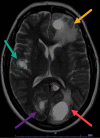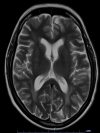Neurotoxicity: A Rare Side Effect of Programmed Cell Death 1 (PD-1) Inhibitors
- PMID: 35355539
- PMCID: PMC8957660
- DOI: 10.7759/cureus.22584
Neurotoxicity: A Rare Side Effect of Programmed Cell Death 1 (PD-1) Inhibitors
Abstract
Immunotherapy is a biological therapy that helps the body's immune system to fight against cancer cells. The Food and Drug Administration (FDA) approved the first immune checkpoint inhibitor in 2011. Since 2011, many immune checkpoint inhibitors have been approved. Programmed cell death 1 (PD-1) inhibitors are now commonly used in multiple malignancies due to their remarkable response. Thus, immune-related adverse events are now coming into the limelight due to the increasing use of PD-1 inhibitors. Here, we present a case of a 54-year-old female with non-small cell lung cancers (NSCLC) treated with pembrolizumab and later presented with severe neurotoxicity.
Keywords: anti-pd-1; immuno-checkpoint inhibitor; immunotherapy adverse effect; lung cancer; non-small cell lung cancer (nsclc).
Copyright © 2022, Ehsanullah et al.
Conflict of interest statement
The authors have declared that no competing interests exist.
Figures


Similar articles
-
Traditional Treatment Approaches and Role of Immunotherapy in Lung Malignancy and Mesothelioma.Cancer Treat Res. 2023;185:79-89. doi: 10.1007/978-3-031-27156-4_5. Cancer Treat Res. 2023. PMID: 37306905
-
Immunotherapy-Induced Auto-Splenectomy in a Patient of Malignant Melanoma.Cureus. 2022 May 17;14(5):e25067. doi: 10.7759/cureus.25067. eCollection 2022 May. Cureus. 2022. PMID: 35600068 Free PMC article.
-
Recent advances in immune checkpoint therapy in non-small cell lung cancer and opportunities for nanoparticle-based therapy.Eur J Pharmacol. 2021 Oct 15;909:174404. doi: 10.1016/j.ejphar.2021.174404. Epub 2021 Aug 4. Eur J Pharmacol. 2021. PMID: 34363829 Review.
-
[Pituitary immune-related adverse events induced by programmed cell death protein 1 inhibitors in advanced lung cancer patients: A report of 3 cases].Beijing Da Xue Xue Bao Yi Xue Ban. 2022 Apr 18;54(2):369-375. doi: 10.19723/j.issn.1671-167X.2022.02.027. Beijing Da Xue Xue Bao Yi Xue Ban. 2022. PMID: 35435206 Free PMC article. Chinese.
-
Programmed Cell Death Protein 1 (PD-1) and Programmed Cell Death Ligand 1 (PD-L1) Immunotherapy: A Promising Breakthrough in Cancer Therapeutics.Cureus. 2023 Sep 2;15(9):e44582. doi: 10.7759/cureus.44582. eCollection 2023 Sep. Cureus. 2023. PMID: 37667784 Free PMC article. Review.
References
-
- Pembrolizumab-induced encephalopathy: a review of neurological toxicities with immune checkpoint inhibitors. Feng S, Coward J, McCaffrey E, Coucher J, Kalokerinos P, O'Byrne K. J Thorac Oncol. 2017;12:1626–1635. - PubMed
-
- Therapeutic prospects of targeting myeloid-derived suppressor cells and immune checkpoints in cancer. Toor SM, Elkord E. Immunol Cell Biol. 2018;96:888–897. - PubMed
Publication types
LinkOut - more resources
Full Text Sources
